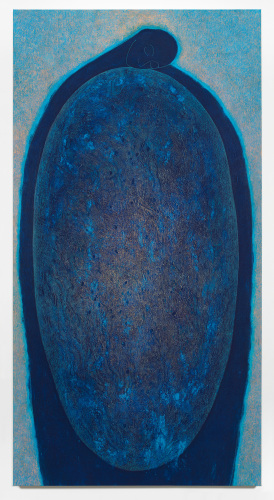
Embrace, 2019. Colored pencil, pastel, and acrylic on canvas, 103 x 53 inches. Photo: Jason Wyche.
Luisa Rabbia: From Mitosis to Rainbow
By Jason Rosenfeld
December 2020/Janaury 2021 Print Issue
Brooklyn-based artist Luisa Rabbia is showing nine new paintings in her fourth solo show at Peter Blum Gallery. The Turin-born Rabbia has worked in multiple media, but this display concentrates on canvases covered by a combination of materials: colored pencil, pastel, acrylic, and oil. They are large pictures, at up to 10 or so feet high or wide. Rabbia has always been a cerebral artist, consummate colorist, and someone committed to social and political issues. Her work is marked by a vivid tactility and fantastical abstraction. The pictures successfully channel the fine art of European Symbolism and psychological Surrealist figuration of Pavel Tchelitchew, as well as the imagery of pulp sci-fi, such as the trippy cover of the Bantam Books edition of Ray Bradbury’s I Sing the Body Electric! from 1971—I well remember it from my father’s library.
The strongest and most effective paintings reprise forms and tonalities Rabbia has used previously. These are less figurally evolved and more suggestive in their use of shapes. The portrait-format Embrace and Threshold (both 2019) and Poles (2020) each feature a similar vertically oriented ovoid shape with a nub at the top that reads as a head. In Embrace she has etched a rudimentary face on it, revealing a recumbent head as somnolent as that of Brancusi’s Sleeping Muse (1910). But the bulbous torso presides in these pictures, a bulk as imposing as that of Rodin’s Balzac, its sketchy outline resembling the way Milton Avery handled small-headed bodies in his late portraits. Munch often used this form, as well, to connote an inward-looking alienation and the inability to connect to others, but Rabbia has turned this hunched human form and the fin-de-siècle symbolist blue color scheme of such artists into a signifier of emotional expansiveness not abnegation. Inner secrets emerge and invite you in. Embrace has a celestial quality, with this central glowing planetary body stretched at top and bottom into an oblate shape, one ringed by a human mandorla, and resemblant of one of Agnes Pelton’s luminous, organic, animation cell-influenced orbs, here grown huge. The glowing fingerprints that activate the center of the rounded mass resemble clusters of electric lighting across the earth as seen from space. In Poles, a rainbow element appears around the inner edge of the central orb where Rabbia has scratched into the oil surface with a metal pen nib in paysage-like sections of repeated strokes. These reveal the multi-hued underpainting resulting in a penumbra of beautifully vibratory color effects. Torsos, nipples, umbilical cords, veins, and delicately mapped circulatory systems give the work a biological intensity, enhanced by the addition of a mysterious second facial form at the bottom.
The show’s title, From Mitosis to Rainbow, implies a progression, or at least a range. Rabbia describes mitosis as “a type of cell division that results in two daughter cells, each having the same number and kind of chromosomes as the parent nucleus, and a process without which there would be no life.” The first work in the display, Nameless (2019), is landscape in format with two shadowy and recumbent bodies, partially overlapping, and enveloped in a gaseous and yellowish atmospheric bubble; their two shared feet poke out at the upper left. The oil surface, typical in Rabbia’s inventive technique, is laid over an acrylic ground. Wearing gloves, she presses into the wet oil on the canvas with her fingers, and then pulls them straight off the surface, resulting in peaks of medium without fingerprint whorls, like miniature volcanoes on a topographical map, ringed by the finger marks. On top of this she draws or shades with colored pencils to enhance the roundness of the forms and the delicate impasto. At the top are a few handprints. Comparisons to Pollock’s Number 1A, 1948 at MoMA or the walls of Lascaux apply, but Rabbia’s picture is less about presence established than trying to convey the act of creation itself. If an idea of the familial doubling of mitosis is inherent in Nameless, then the rainbow concludes the show in the final, largest, and most recent work, I Am Rainbow (2020). It is the last painting you see as you move clockwise around the main room and is tellingly hung on the opposite side of the wall bearing Nameless. Over seven feet high and 10 feet wide, I Am Rainbow, at a distance, looks like a massive detail of a heavily mascaraed single eye from a human head in an Egyptian tomb painting. But up close, details emerge. This central, egg-like form with pinched ends lies on its long side, its elliptical shape echoed by colored rivulets of blue and orange and green that flow above and below it from right to left and respond to its contours. At the left edge, on a scrim of peach-colored matte background, these streams terminate in around 30 human feet that lie parallel to the upper and lower edges of the picture, their toes mere inches from the left edge, a communal extension of the two feet in Nameless. The planetary theme in the other pictures continues here—the pulsing eye/egg eventually came to resemble Jupiter’s Great Red Spot as I spent more time with it. I Am Rainbow is a demonstrably hopeful image, made by the artist in the midst of this trying year, a kind of coalition-building in paint. The various celestial references in pictures populated by fingerprints throughout this worthy show connote a Whitmanesque celebration of the multitudinous.